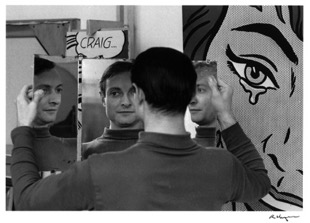Archives of American Art Announces Major Promised Gift From the Roy Lichtenstein Foundation
The Smithsonian’s Archives of American Art announced that it is the beneficiary of a major promised gift from the Roy Lichtenstein Foundation: the expansive Roy Lichtenstein Foundation records and Roy Lichtenstein papers comprising over 500 linear feet. The gift constitutes the most complete research resource anywhere on the art and life of the artist and his times, illuminating Lichtenstein’s wide-reaching influence and legacy. The foundation will support the digitization of the collection in collaboration with the Archives and will gift the papers in stages. Initial processing of these comprehensive records has begun, and access to the collection will be free and available on the Archives’ website.
The material includes the artist’s voluminous studio records, approximately 300 oral-history interviews that have been transcribed, exhibition and art-object files, the audiovisual collection, personal and professional correspondence and thousands of documentary photographs of the artist, his art and exhibition installations.
The Lichtenstein Foundation selected the Archives and the Whitney Museum of American Art in New York City to participate in the long-term collaboration, which is aimed at greatly facilitating public access to the art and history of the artist. In addition to the pledge to the Archives, the foundation is establishing the Roy Lichtenstein Study Collection at the Whitney, initiated with the promised gift of more than 400 artworks from all periods of his career (1940–97).
“This extraordinary pledge represents a transformative moment for the Archives and those who use our collections in person and online every day,” said Kate Haw, director of the Archives of American Art. “We are profoundly grateful for the generosity and vision of the Roy Lichtenstein Foundation that will enable access to this exceptional breadth of material enhancing our understanding of one of the most important American artists of the past century. We are enormously proud that the Lichtenstein Foundation chose to entrust the Archives to help preserve and expand the artist’s legacy alongside the study collection at the Whitney Museum. Working with the Lichtenstein Foundation over the past few years has been so rewarding, and the result of the gift of both the papers and support for their digitization is an exemplary model for our field.”
“We have always intended that the foundation, now almost 20 years old, would not operate in perpetuity,” said Dorothy Lichtenstein, president of the foundation. “We are delighted that we can create a new way forward with our first set of chosen successor institutions. We will continue to refine and expand these projects and to facilitate research opportunities, well before we actually ‘sunset.’ We feel privileged that all levels of the Whitney Museum and the Archives of American Art are so enthusiastic and have embraced our initial ideas. We hope this is a useful model for other artists and artists’ foundations, estates or trusts.”
The donation robustly amplifies the material about Lichtenstein currently in the Archives’ collections, including records from the Leo Castelli Gallery, the artist’s principal gallery from 1962 until his death in 1997. The two most consulted series of the Castelli archive—the exhibition files and the photographs—were digitized in 2016 with the foundation’s support.
Among the Archives’ holdings are a nearly five-hour interview with Lichtenstein conducted in 1963–64 for its oral-history program and collections revealing hundreds of connections with Lichtenstein and his contemporaries. A notable treasure is Lichtenstein’s preliminary sketch for his painting As I Opened Fire (1964) and the comic strip on which it was based, which were donated to the Archives by collector Richard Brown Baker.
Letters from Lichtenstein and significant research materials about him are among the papers of art historians Ruth Fine and Ellen Hulda Johnson, curators Nan Rosenthal and Samuel Wagstaff, art dealer Ivan C. Karp, art writer and photographer John Gruen and many others. The Rudy Burckhardt papers include hundreds of black-and-white negatives of works of art by Lichtenstein. There are also photographs of him among the papers of Hans Namuth, Lenore Seroka and Alan R. Solomon.
“The addition of the Lichtenstein material to the existing collections is a vibrant example of the deep network of connections across centuries of American art history accessible at the Archives,” Haw said.
About the Archives of American Art
Founded in 1954, the Archives of American Art fosters advanced research through the accumulation and dissemination of primary sources, unequaled in historical depth and breadth, that document more than 200 years of the nation’s artists and art communities. The Archives provides access to these materials through its exhibitions and publications, including Archives of American Art Journal, the longest-running scholarly journal in the field of American art. An international leader in the digitizing of archival collections, the Archives also makes nearly 3 million images freely available online. The oral-history collection includes more than 2,400 audio interviews, the largest accumulation of in-depth, first-person accounts of the American art world. www.aaa.si.edu
About the Roy Lichtenstein Foundation
Opened in 1999, the foundation’s primary mission is to facilitate public access to the work of Roy Lichtenstein and contemporary art, in general. The foundation continues research for its production of a web-based catalogue raisonné of all Lichtenstein work. It has previously created the Harry Shunk-Janos Kender Photography Collection when the foundation was able to rescue and preserve the enormous Harry Shunk estate photography holdings. These crucial visual documents of European and American 1960s/1970s artist actions and performances, exhibitions and artists working in their studios were fully archived and subsequently donated to the Getty Research Institute, the Museum of Modern Art, the National Gallery of Art, Tate and Centre Georges Pompidou. Additional partnerships are still being planned for both Shunk-Kender materials as well as the foundation’s holdings of Roy Lichtenstein.
# # #
SI-326-2017

